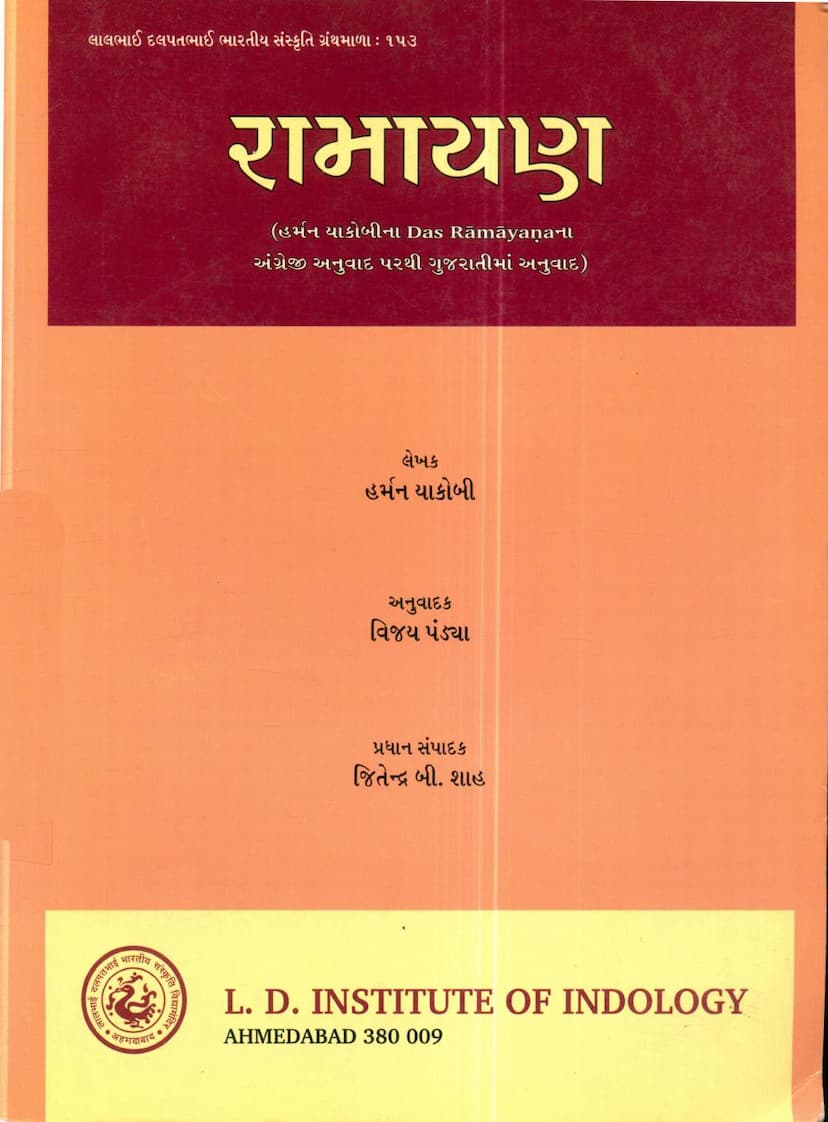Ramayan
Added to library: September 2, 2025

Summary
Here is a comprehensive summary of the Jain text "Ramayan" by Harman Jacobi, translated into Gujarati by Vijay Pandya, published by L. D. Institute of Indology, Ahmedabad:
This book is a Gujarati translation of Herman Jacobi's seminal work, "Das Ramayana." The translation was undertaken by Vijay Pandya, with Jitendra B. Shah serving as the Chief Editor. Published in 2012 by the L. D. Institute of Indology, Ahmedabad, this publication aims to make Jacobi's profound research on the Ramayana accessible to Gujarati-speaking scholars and enthusiasts.
The preface highlights the Ramayana and Mahabharata as cornerstones of Indian culture, guiding society and thinkers through centuries and influencing global cultures. It specifically praises Professor Herman Jacobi, a renowned scholar of Indian studies, for his detailed and research-oriented analysis of the Ramayana. The translator, Professor Vijay Pandya, a Sanskrit scholar and avid reader of the Ramayana, expresses his deep respect and devotion to Lord Rama, finding joy and pride in making this important scholarly work available in Gujarati. He emphasizes the book's enduring relevance and the need to bridge the gap created by the limited prevalence of English in Gujarat's academic sphere.
Key aspects of Professor Jacobi's research, as presented in the book, include:
- Critical Study: The book is presented as an exemplary model for a critical study of the Valmiki Ramayana, emphasizing the importance of a critical perspective in academic pursuits.
- Textual Analysis (Vachanas): Jacobi's research meticulously examines different recensions (versions) of the Ramayana, identifying variations and their origins. He categorizes these into three main groups:
- The prevalent "Northern Recension" (referred to as "C" for commentator's readings), based on the Bombay edition.
- The "Bengali Recension" (referred to as "B"), found in Gorresio's edition.
- The "Western Recension" (referred to as "A"), identified by Gillemistre and based on manuscripts from Bonn and Kashmir.
- He analyzes the interrelationships between these recensions, noting how they differ in individual verses, significant passages, and entire chapters, as well as in the sequence of verses.
- Interpolations and Additions (Prakshipta Ansho): A significant portion of Jacobi's work is dedicated to identifying and analyzing passages that are likely later additions or interpolations. He uses various criteria for this analysis, including:
- Metrical Irregularities: Jacobi meticulously examines the metrical structure (Chhanda) of verses, noting deviations from the established meters like Anushtubh and Vipula as potential indicators of later additions. He provides numerous examples from various Kandas (books) to support his claims.
- Linguistic and Grammatical Peculiarities: He looks for linguistic anachronisms, unusual grammatical constructions, and stylistic differences that might point to different authorship or periods of composition.
- Inconsistencies and Contradictions: Jacobi identifies internal inconsistencies within the narrative, such as events being described out of order, repeated passages with variations, or information that contradicts earlier or later parts of the epic. He argues that such inconsistencies often arise when later interpolations are inserted without proper integration into the existing narrative flow.
- Thematic and Ideological Shifts: He points out how certain themes or theological interpretations, such as the increasing divinity of Rama or specific philosophical concepts, appear more prominently in later sections, suggesting a gradual evolution and accretion of material.
- Historical and Cultural Context: Jacobi situates the Ramayana within its historical and cultural milieu, discussing the evolution of the epic from oral traditions to a written text, the role of bards and performers (Kushilavas), and the influence of geographical regions and political changes on the text's development.
- Theories on Origin and Development: He explores various theories regarding the composition of the Ramayana, including the possibility of multiple authors, the gradual expansion of the text over centuries, and the potential influence of other traditions, such as Greek mythology (though he largely refutes direct borrowing). He emphasizes the complex process of the epic's formation, involving oral transmission, adaptation by various performers, and eventual compilation.
- The Role of Brahmanas: Jacobi debates the theory that Brahmanas might have altered the text for their own purposes, ultimately concluding that while later interpolations exist, they generally align with the core concepts of the original work and don't represent a radical ideological shift for self-serving reasons.
- Dating the Ramayana: Based on his extensive analysis of textual variations, linguistic features, and historical references (including astronomical and geographical details), Jacobi attempts to place the composition of the Ramayana within a specific historical period, suggesting it likely began to take shape in the 5th or 6th century BCE, with later additions extending over several centuries.
- Comparative Analysis: He compares the Ramayana with other Indian epics like the Mahabharata and with early Buddhist literature (specifically the Dasaratha Jataka) to highlight similarities, differences, and potential influences.
The book is structured into three main sections: "Vachanas" (Recensions), "Prakshipta Ansho vishe Mahiti" (Information on Interpolated Passages), and "Bharatiya Sahityama Ramayan nu Sthan" (The Place of Ramayana in Indian Literature), which delves into its origin and development.
In essence, this Gujarati translation of Herman Jacobi's "Ramayana" offers a rigorous and detailed academic exploration of the epic, dissecting its layers of composition, analyzing its textual history, and providing valuable insights into its cultural and historical context. It is a foundational work for anyone seeking a deep understanding of the Valmiki Ramayana from a scholarly perspective.